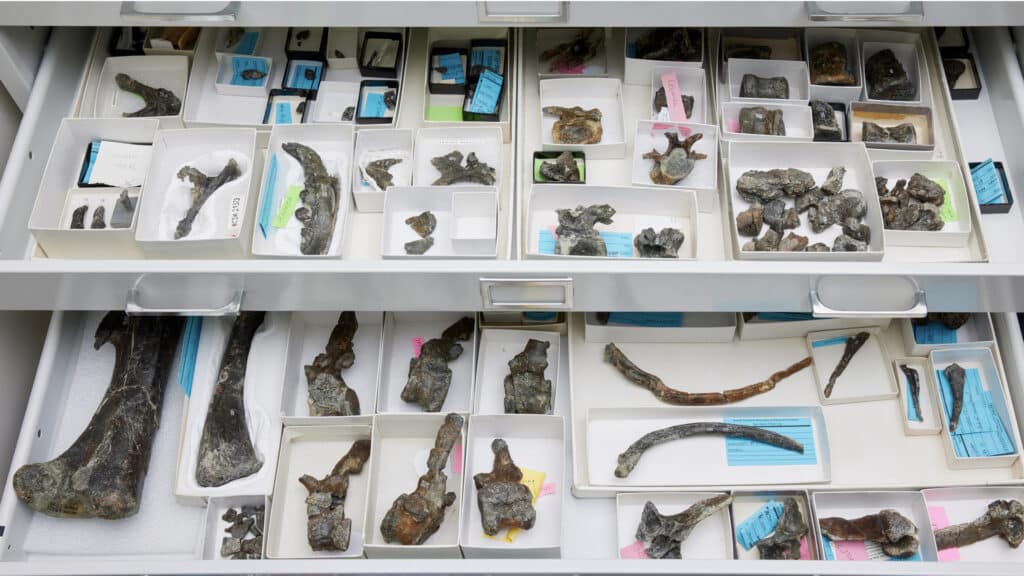New Dino, ‘Iani,’ Was Face of a Changing Planet
For Immediate Release
A newly discovered plant-eating dinosaur may have been a species’ “last gasp” during a period when Earth’s warming climate forced massive changes to global dinosaur populations.
The specimen, named Iani smithi after Janus, the two-faced Roman god of change, was an early ornithopod, a group of dinosaurs that ultimately gave rise to the more commonly known duckbill dinosaurs such as Parasaurolophus and Edmontosaurus. Researchers recovered most of the juvenile dinosaur’s skeleton – including skull, vertebrae and limbs – from Utah’s Cedar Mountain Formation.
Iani smithi lived in what is now Utah during the mid-Cretaceous, approximately 99 million years ago. The dinosaur’s most striking feature is its powerful jaw, with teeth designed for chewing through tough plant material.
The mid-Cretaceous was a time of big changes, which had big effects on dinosaur populations. Increased atmospheric carbon dioxide during this time caused the Earth to warm and sea levels to rise, corralling dinosaurs on smaller and smaller landmasses. It was so warm that rainforests thrived at the poles. Flowering plant life took over coastal areas and supplanted normal food sources for herbivores.
In North America, giant plant-eating sauropods – once titans of the landscape – were disappearing, along with their allosaurian predators. At the same time, smaller plant eaters, like early duckbills and horned dinosaurs, and feathered theropods like tyrannosaurs and enormous oviraptorosaurs, were arriving from Asia.
Enter Iani smithi, unique not only because it’s newly discovered, but also because of its rarity in the North American fossil record and its position in dinosaur history.
“Finding Iani was a streak of luck. We knew something like it lived in this ecosystem because isolated teeth had been collected here and there, but we weren’t expecting to stumble upon such a beautiful skeleton, especially from this time in Earth’s history. Having a nearly complete skull was invaluable for piecing the story together,” says Lindsay Zanno, associate research professor at North Carolina State University, head of paleontology at the North Carolina Museum of Natural Sciences, and corresponding author of the work.

Credit: National Geographic, Mark Thiessen and Becky Hale
License: CC-BY-NC
Zanno and her team used the well-preserved skeleton to analyze the evolutionary relationships of Iani and were surprised – and a bit skeptical – of the results.
“We recovered Iani as an early rhabdodontomorph, a lineage of ornithopods known almost exclusively from Europe,” Zanno says. “Recently, paleontologists proposed that another North American dinosaur, Tenontosaurus – which was as common as cattle in the Early Cretaceous – belongs to this group, as well as some Australian critters. If Iani holds up as a rhabdodontomorph, it raises a lot of cool questions.”
Key among these is, could Iani be a last gasp, a witness to the end of a once successful lineage? Zanno thinks that studying this fossil in the context of environmental and biodiversity changes during the mid-Cretaceous will give us more insight into the history of our planet.
Iani smithi is named for Janus, the two-faced god who symbolized transitions – an apt name, given its position in history.
“Iani may be the last surviving member of a lineage of dinosaurs that once thrived here in North America but were eventually supplanted by duckbill dinosaurs,” Zanno says. “Iani was alive during this transition – so this dinosaur really does symbolize a changing planet.
“This dinosaur stood on the precipice,” she says, “able to look back at the way North American ecosystems were in the past, but close enough to see the future coming like a bullet train. I think we can all relate to that.”
The work appears in PLOS ONE and was supported by the National Science Foundation. Zanno is lead author as well as corresponding. Terry Gates and Haviv Avrahami, both of NC State and the North Carolina Museum of Natural Sciences, along with Ryan Tucker of Stellenbosch University and Peter Makovicky of the University of Minnesota, also contributed to the work.
-peake-
Note to editors: An abstract follows.
“An early-diverging iguanodontian (Dinosauria: Rhabdodontomorpha) from the Late Cretaceous of North America”
DOI: 10.1371/journal.pone.0286042
Authors: Lindsay Zanno, Terry Gates, Haviv Avrahami, North Carolina State University and the North Carolina Museum of Natural Sciences; Ryan Tucker, Stellenbosch University, Stellenbosch, South Africa; Peter Makovicky, University of Minnesota
Published: June 7 in PLOS ONE
Abstract:
Intensifying macrovertebrate reconnaissance together with refined age-dating of mid-Cretaceous assemblages in recent decades is producing a more nuanced understanding of the impact of the Cretaceous Thermal Maximum on terrestrial ecosystems. Here we report discovery of a new early-diverging ornithopod, Iani smithi gen. et sp. nov., from the Cenomanian-age lower Mussentuchit Member, Cedar Mountain Formation of Utah, USA. The single known specimen of this species (NCSM 29373) includes a well-preserved, disarticulated skull, partial axial column, and portions of the appendicular skeleton. Apomorphic traits are concentrated on the frontal, squamosal, braincase, and premaxilla, including the presence of three premaxillary teeth. Phylogenetic analyses using parsimony and Bayesian inference posit Iani as a North American rhabdodontomorph based on the presence of enlarged, spatulate teeth bearing up to 12 secondary ridges, maxillary teeth lacking a primary ridge, a laterally depressed maxillary process of the jugal, and a posttemporal foramen restricted to the squamosal, among other features. Prior to this discovery, neornithischian paleobiodiversity in the Mussentuchit Member was based primarily on isolated teeth, with only the hadrosauroid Eolambia caroljonesa named from macrovertebrate remains. Documentation of a possible rhabdodontomorph in this assemblage, along with published reports of an as-of-yet undescribed thescelosaurid, and fragmentary remains of ankylosaurians and ceratopsians confirms a minimum of five, cohabiting neornithischian clades in earliest Late Cretaceous terrestrial ecosystems of North America. Due to poor preservation and exploration of Turonian–Santonian assemblages, the timing of rhabdodontomorph extirpation in the Western Interior Basin is, as of yet, unclear. However, Iani documents survival of all three major clades of Early Cretaceous neornithischians (Thescelosauridae, Rhabdodontomorpha, and Ankylopollexia) into the dawn of the Late Cretaceous of North America.
This post was originally published in NC State News.